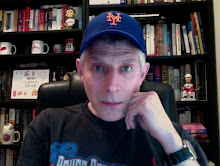Between 1971 and 1975, he'd led them to five straight first place finishes, and from '72 to ''74, three consecutive championships, then he was gone, traded just before opening day 1976.
 |
| Reggie Jackson of the 1987 Oakland Athletics. |
Home, after four American League home run titles and the 1973 AL Most Valuable Player award.
Home, after 14 All Star Game selections and two World Series MVP awards, the second of which came after he crushed the Los Angeles Dodgers, hitting three round trippers in three swings to close out the 1977 fall classic.
Home after a year in Baltimore, five in the Bronx and five more in Anaheim, playing for the argumentative Earl Weaver, the tempestuous Billy Martin, the calming Bob Lemon, the defiant Dick Howser and the luckless Gene Mauch. Home after playing for Charlie Finley, George Steinbrenner and Gene Autry.
Home as Mr. October, as the self-proclaimed "Straw that Stirs the Drink." Home as a candy bar. "When you unwrap a Reggie Bar, it tells you how good it is," his Hall of Fame teammate Catfish Hunter once said. Now, in his final season, Reggie no longer needed to be the bonbon, the straw or even a main ingredient in the Oakland Athletic's potent cocktail, he just needed to be in the mix.
Managed by future Hall member Tony La Russa, the A's franchise was on one if it's periodic upswings, if not yet at its peak. First-baseman Mark McGwire, 23, was in the midst of a freshman campaign that would see him hit .289 with 49 homers and 118 runs batted in, winning Rookie of the Year honors. Behind him, 1986 AL Rookie of the Year Jose Canseco, just 21 and on his way to belting 31 round-trippers and driving in 113. Together they were The Bash Brothers.
McGwire, Canseco and Reggie, men who would combine for 1,608 home runs over their careers, together in one Athletics line up. Surely somewhere Jimmie Foxx was lacing his cleats.
Joining them: 1979 co-RotY shortstop Alfredo Griffin and 1981 AL batting champ Carney Lansford, starting pitcher Dave Stewart -- embarking on the first of his four consecutive 20-win seasons -- and Hall of Fame reliever Dennis Eckersley.
"I think the ingredients are all here for me to have a good year," Jackson, bash brother emeritus, said in one of two features about him in the game program for July 27, 1987, when his team hosted the California Angels at the Oakland Alameda County Coliseum.
 |
| The Oakland-Alameda County Coliseum, July 27, 1987 |
The A's, behind Stewart, cruised to a 6-1 win that night. Only catcher Terry Steinbach homered for the home team. Shortstop Gus Polidor struck a blow for the visitors.
Jackson -- batting sixth -- struck out four times (a drop in his MLB-record bucket of 2597 Ks, which still stands today). He ended the night hitting a discouraging .203. For the year, he batted .220 with 15 homers and 43 RBIs. In 336 at bats over 115 games, he struck out 97 times.
Reggie finished his illustrious career with a .262 batting average, 563 homers and 1,702 runs batted in. He also had 18 round-trippers and 48 RBIs in 77 post-season games, 10 of those clouts in the series. He made the Hall in 1993.
The Coup
Two weeks before my visit, stop four on my California/ballpark tour, the Coliseum had hosted Major League Baseball's All Star Game, further proof the sometimes moribund A's, whose attendance had dipped to 306,763 for the entire 1979 season, were on the rebound. For those of us who care, the All Star Game program -- in this era before eBay -- was a trophy worth hunting.
 |
| The trophy |
He said he had none and directed me down the concourse, past the first aid station and through a door where I found myself in a souvenir stock room.
"Hi. Mike sent me," I told a woman behind the counter, feigning a casualness I didn't feel. "I'm looking for an All Star Game program."
She dropped back into the steel shelving behind her and reappeared moments later, program in hand.
"Do you work here?" she asked, looking me over.
"Five dollars," she said. I handed over the money, suppressed a smile and walked out. Quickly.
_____________________________
In the Summer of 1987, soon after graduating from college, me and my buddy Chris took a baseball tour of California. Mostly baseball at least, and hell of a good time. This is the fifth part of a series inspired by those 16 days on the road.
-- Follow me on Twitter @paperboyarchive


No comments:
Post a Comment